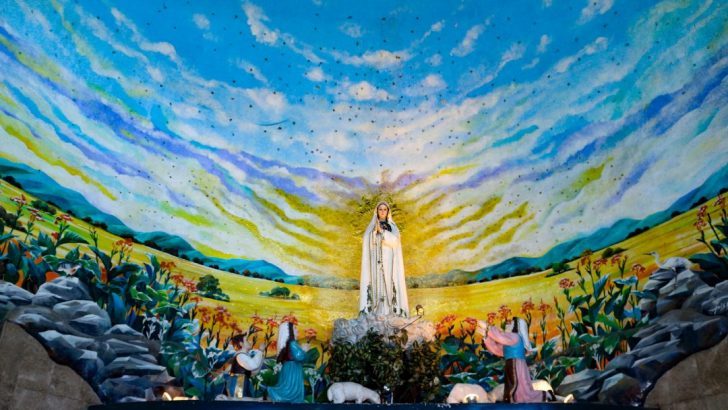Greg Daly explores one of the Portuguese appartions’ most intriguing aspects
In the decades following the apparitions, Fatima was mainly known, like Lourdes and other Marian sites, as a place of healing. However, in her 1941 memoirs, Sr Lucia wrote about how during Our Lady’s third apparition, she gave the children a message in three parts, which has become known as the ‘Great Secret of Fatima’.
As Sr Lucia described the message, it began with a vision of hell, about which Our Lady said, “You have seen hell where the souls of poor sinners go. To save them, God wishes to establish in the world devotion to my Immaculate Heart. If what I say to you is done, many souls will be saved and there will be peace.”
She continued by saying, “The war is going to end: but if people do not cease offending God, a worse one will break out during the Pontificate of Pius XI.”
It might seem natural to point out that the Second World War began in September 1939, by which time Pius XII had succeeded Pius XI, but it is worth remembering how in 1935, Italy had invaded Abyssinia, with the Spanish Civil War – in which Germany and the Soviet Union took opposite sides – starting in 1936, and Japan invading Manchuria in 1937: the three Axis powers were already at war during Pius XI’s reign, as – crucially – was Soviet Russia.
Visible
Also within Pius XI’s papacy, January 1938 would see a remarkable Aurora Borealis visible across Europe, even as far south as Gibraltar, and it is often thought that this too featured in the second part of the secret.
“When you see a night illumined by an unknown light, know that this is the great sign given you by God that he is about to punish the world for its crimes, by means of war, famine, and persecutions of the Church and of the Holy Father,” Sr Lucia recorded Our Lady as having said, before calling for the consecration of Russia to her Immaculate Heart and the Communion of reparation on the First Saturdays.
In the aftermath following the Second World War, the publication of these first parts of the secret offered many a spiritual framework in which to understand the 20th Century, with its world wars, the rise of communism, and the Cold War, so Fatima acquired a unique place among the holy places of Christendom, a key piece in the Church’s response to the threat of communism.
The third part of the secret, rather than being published, was written down in 1944 on the instructions of “the Bishop of Leiria and the Most Holy Mother”, and was sealed and sent to the Vatican, with instructions that it remained sealed until at least 1960. Although St John XXIII and Blessed Paul VI read the text, they declined to publish it, as, for most of his papacy, did St John Paul II, although having read it in 1981 he prayed for the consecration of the whole world to Mary’s Immaculate Heart, repeating this in Fatima the following year and again in Rome in 1984. Sr Lucia subsequently wrote to him, confirming that he had done as Our Lady had wished.
In 2000, however, he arranged for its publication, with extensive notations from the then Cardinal Joseph Ratzinger, and an introduction from the then Archbishop Tarcisio Bertone.
The future Secretary of State to Pope Benedict XVI related how Sr Lucia herself believed the third part of the secret to be a “symbolic revelation”, relating to Our Lady’s warning about how if her words were not heeded, Russia would “spread her errors throughout the world, causing wars and persecutions of the Church” such that “the good will be martyred; the Holy Father will have much to suffer; various nations will be annihilated”.
As Sr Lucia saw it, Russia had indeed invaded the world with her errors, and its repercussions were ongoing. And yet, she said, it was important to understand that this was not a divine punishment, but simply the working out of human sinfulness.
“And let us not say that it is God who is punishing us in this way; on the contrary it is people themselves who are preparing their own punishment. In his kindness God warns us and calls us to the right path, while respecting the freedom he has given us; hence people are responsible,” she said.
The secret, as the future Pope Benedict XVI described it, showed “the Church of the martyrs of the century which has just passed represented in a scene described in a language which is symbolic and not easy to decipher”.
After careful explanations of the nature and value of private revelations, the future Pope noted how, for instance, an image of an angel with a flaming sword recalled biblical images representing the threat of judgment on the world, and observed: “Today the prospect that the world might be reduced to ashes by a sea of fire no longer seems pure fantasy: man himself, with his inventions, has forged the flaming sword.”
Against this, he says, the splendour of the Mother of God stands as a summons to penance and a sign of human freedom, showing how the future is not “unchangeably set”, so we can turn to the God’s light.
Subsequent images of “a bishop dressed in white”, who the children believed to be the Pope, along with other bishops, priests, and men and women religious climbing a steep mountain and passing through a ruined city to a large cross, where the white-clad bishop and the others were shot down by a group of soldiers, pointed, Cardinal Ratzinger said, to the 20th Century as “a century of martyrs, a century of suffering and persecution for the Church, a century of World Wars and the many local wars which filled the last 50 years and have inflicted unprecedented forms of cruelty”.
The bishop in white, he said, was a convergence of different Popes, while the final image, in which two angels gathered the blood of the martyrs and sprinkled the souls on their way to God, was, he said, “a consoling vision, which seeks to open a history of blood and tears to the healing power of God”.
Perhaps predictably, some devotees refuse to believe the entire secret has been released, partly because in 1960 the Vatican issued a press release stating that it was “most probable the secret would remain, forever, under absolute seal”.
Indeed, one German professor claimed last year the then Cardinal Ratzinger had told him that part of the secret – supposedly about “a bad council and a bad Mass” – remained unpublished, but this mispresentation prompted the Pope Emeritus to use the Vatican Press Office to make a rare public statement:
“In this regard, Pope emeritus Benedict XVI declares ‘never to have spoken with Prof. Dollinger about Fatima’,” the statement said, continuing, “clearly affirming that the remarks attributed to Prof. Dollinger on the matter ‘are pure inventions, absolutely untrue’, and he confirms decisively that ‘the publication of the Third Secret of Fatima is complete’.”
There the matter should surely rest.


 Greg Daly
Greg Daly
